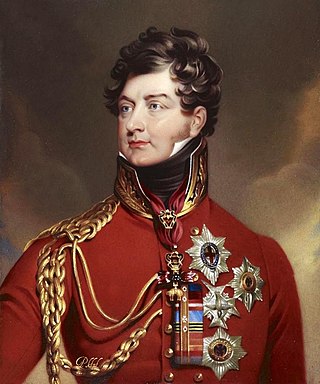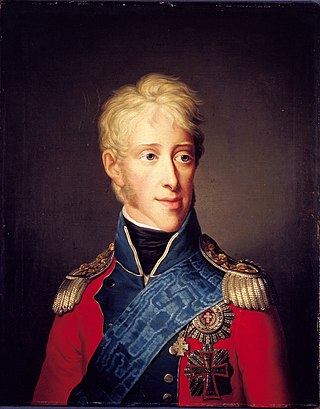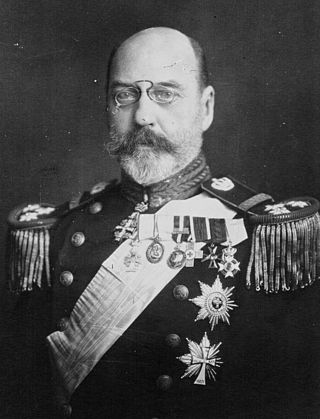Related Research Articles

Pope Celestine III, was the head of the Catholic Church and ruler of the Papal States from 30 March or 10 April 1191 to his death in 1198. He had a tense relationship with several monarchs, including Emperor Henry VI, King Tancred of Sicily, and King Alfonso IX of León.

Charles XIV John was King of Sweden and Norway from 1818 until his death in 1844. Before his reign he was a Marshal of France during the Napoleonic Wars and participated in several battles. In modern Norwegian lists of kings he is called Charles III John. He was the first monarch of the Bernadotte dynasty.

A prince regent or princess regent is a prince or princess who, due to their position in the line of succession, rules a monarchy as regent in the stead of a monarch regnant, e.g., as a result of the sovereign's incapacity or absence.

Margrethe II is Queen of Denmark. Having reigned as Denmark's monarch for over 50 years, she is Europe's longest-serving current head of state.

Haakon VII was the King of Norway from November 1905 until his death in September 1957.

Christian X was King of Denmark from 1912 to his death in 1947, and the only King of Iceland as Kristján X, in the form of a personal union rather than a real union between 1918 and 1944.

Christian IX was King of Denmark from 1863 until his death in 1906. From 1863 to 1864, he was concurrently Duke of Schleswig, Holstein and Lauenburg.

The Battle of Copenhagen of 1801, also known as the First Battle of Copenhagen to distinguish it from the Second Battle of Copenhagen in 1807, was a naval battle in which a British fleet fought and defeated a smaller force of the Dano-Norwegian Navy anchored near Copenhagen on 2 April 1801. The battle came about over British fears that the powerful Danish fleet would ally with France, and a breakdown in diplomatic communications on both sides.

Frederick IX was King of Denmark from 1947 to 1972. Born into the House of Glücksburg, Frederick was the elder son of King Christian X and Queen Alexandrine of Denmark. He became crown prince when his father succeeded as king in 1912. As a young man, he was educated at the Royal Danish Naval Academy. In 1935, he was married to Princess Ingrid of Sweden and they had three daughters, Margrethe, Benedikte and Anne-Marie. During Nazi Germany's occupation of Denmark, Frederick acted as regent on behalf of his father from 1942 until 1943. Frederick became king on his father's death in early 1947. During Frederick IX's reign Danish society changed rapidly, the welfare state was expanded and, as a consequence of the booming economy of the 1960s, women entered the labour market. The modernization brought new demands on the monarchy and Frederick's role as a constitutional monarch. Frederick IX died in 1972, and was succeeded by his eldest daughter, Queen Margrethe II.

Frederick VI was King of Denmark from 13 March 1808 to 3 December 1839 and King of Norway from 13 March 1808 to 7 February 1814, making him the last king of Denmark–Norway. From 1784 until his accession, he served as regent during his father's mental illness and was referred to as the "Crown Prince Regent". For his motto he chose God and the just cause and since the time of his reign, succeeding Danish monarchs have also chosen mottos in the Danish language rather than the formerly customary Latin. As Frederick VI had no surviving sons to succeed him, he was succeeded on the throne of Denmark by his half-first cousin Christian, who was his father's half-brother's son.

George I was King of Greece from 30 March 1863 until his assassination in 1913.

Prince George of Denmark was the husband of Anne, Queen of Great Britain. He was the consort of the British monarch from Anne's accession on 8 March 1702 until his death in 1708.

Frederik, Crown Prince of Denmark, Count of Monpezat, is the heir apparent to the Danish throne. He is the elder son of Queen Margrethe II and Prince Henrik.

Ernest Augustus, Crown Prince of Hanover, 3rd Duke of Cumberland and Teviotdale, was the eldest child and only son of George V of Hanover and his wife, Marie of Saxe-Altenburg. Ernest Augustus was deprived of the thrones of Hanover upon its annexation by Prussia in 1866 and later the Duchy of Brunswick in 1884. Although he was the most senior male-line descendant of George I, II, and III, the Duke of Cumberland was deprived of his British peerages and honours for having sided with Germany in World War I. Ernest Augustus was the last Hanoverian prince to hold a British royal title and the Order of the Garter.

The Order of the Elephant is a Danish order of chivalry and is Denmark's highest-ranked honour. It has origins in the 15th century, but has officially existed since 1693, and since the establishment of constitutional monarchy in 1849, is now almost exclusively used to honour royalty and heads of state.
The Prince of Denmark's March, commonly called the Trumpet Voluntary, was written around 1700 by the English composer Jeremiah Clarke, the first organist of the then newly-rebuilt St Paul's Cathedral.

Caroline Matilda of Great Britain was Queen of Denmark and Norway from 1766 to 1772 by marriage to King Christian VII.

Prince Valdemar of Denmark was a member of the Danish royal family. He was the third son and youngest child of Christian IX of Denmark and Louise of Hesse-Kassel. He had a lifelong naval career.

Prince Charles of Hesse-Kassel was a cadet member of the house of Hesse-Kassel and a Danish general field marshal. Brought up with relatives at the Danish court, he spent most of his life in Denmark, serving as royal governor of the twin duchies of Schleswig-Holstein from 1769 to 1836 and commander-in-chief of the Norwegian army from 1772 to 1814.

Prince Gustav of Denmark was a member of the Danish royal family. He was the fourth and youngest son and seventh child of King Frederick VIII and Queen Louise.
References
- ↑ Palmer p.18